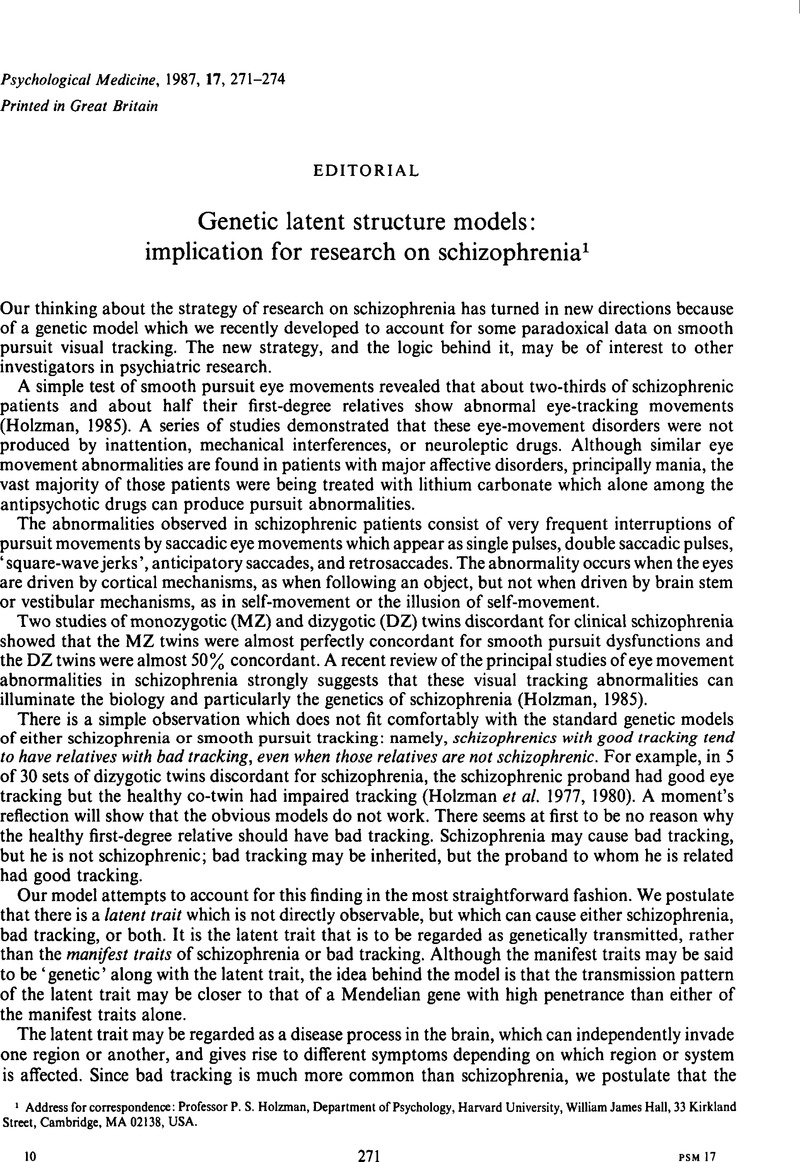Crossref Citations
This article has been cited by the following publications. This list is generated based on data provided by Crossref.
Parnas, J.
Jørgensen, Å.
Teasdale, T.W.
Schulsinger, F.
and
Mednick, S.A.
1988.
Temporal course of symptoms and social functioning in relapsing schizophrenics: A 6-year follow-up.
Comprehensive Psychiatry,
Vol. 29,
Issue. 4,
p.
361.
Gordon, Harold W.
1989.
The Problem of Studying Specific Learning Disabilities and the Contribution of Hemispheric Specialisation.
The Irish Journal of Psychology,
Vol. 10,
Issue. 4,
p.
479.
Prentky, Robert
1989.
Handbook of Creativity.
p.
243.
1991.
Social competence and positive and negative symptoms: a longitudinal study of children and adolescents at risk for schizophrenia and affective disorder.
American Journal of Psychiatry,
Vol. 148,
Issue. 9,
p.
1182.
Muir, Walter J.
St Clair, David M.
Blackwood, Douglas H. R.
Roxburgh, Hilary M.
and
Marshall, Ian
1992.
Eye-tracking dysfunction in the affective psychoses and schizophrenia.
Psychological Medicine,
Vol. 22,
Issue. 3,
p.
573.
Holzman, Philip S.
1992.
Behavioral markers of schizophrenia useful for genetic studies.
Journal of Psychiatric Research,
Vol. 26,
Issue. 4,
p.
427.
Blackwood, D. H. R.
and
Muir, W. J.
1992.
Genetic Research in Psychiatry.
p.
193.
Cornblatt, Barbara A.
Lenzenweger, Mark F.
Dworkin, Robert H.
and
Erlenmeyer-Kimling, L.
1992.
Childhood Attentional Dysfunctions Predict Social Deficits in Unaffected Adults at Risk for Schizophrenia.
British Journal of Psychiatry,
Vol. 161,
Issue. S18,
p.
59.
Goldstein, Jill M.
Seidman, Larry J.
Santangelo, Susan
Knapp, Peter H.
and
Tsuang, Ming T.
1994.
Are schizophrenic men at higher risk for developmental deficits than schizophrenic women? Implications for adult neuropsychological functions.
Journal of Psychiatric Research,
Vol. 28,
Issue. 6,
p.
483.
Suinn, Richard M.
1995.
Schizophrenia and bipolar disorder: Origins and influences.
Behavior Therapy,
Vol. 26,
Issue. 4,
p.
557.
Kelley, Michael P.
and
Bakan, Paul
1999.
Eye Tracking in Normals: Spem Asymmetries and Association with Schizotypy.
International Journal of Neuroscience,
Vol. 98,
Issue. 1-2,
p.
27.
Price, Gregory W.
Michie, Patricia T.
Johnston, Julie
Innes-Brown, Hamish
Kent, Aaron
Clissa, Peter
and
Jablensky, Assen V.
2006.
A Multivariate Electrophysiological Endophenotype, from a Unitary Cohort, Shows Greater Research Utility than Any Single Feature in the Western Australian Family Study of Schizophrenia.
Biological Psychiatry,
Vol. 60,
Issue. 1,
p.
1.
Jablensky, Assen
2009.
The Handbook of Neuropsychiatric Biomarkers, Endophenotypes and Genes.
p.
41.
Levy, Deborah L.
Sereno, Anne B.
Gooding, Diane C.
and
O’Driscoll, Gilllian A.
2010.
Behavioral Neurobiology of Schizophrenia and Its Treatment.
Vol. 4,
Issue. ,
p.
311.
Bearden, Carrie E.
Winkler, Anderson
Karlsgodt, Katherine H.
and
Bilder, Robert
2016.
Neurophenotypes.
p.
61.



